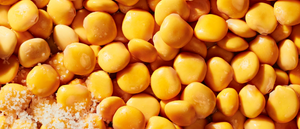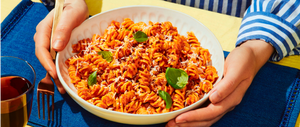-
What is BRAMI?
BRAMI is commonly known by its Italian name lupini because of the large Italian American community in America. The beans are part of the lupin family of legumes that are distant relatives of the peanut. Lupins are the only legumes that are indigenous to two separate continents (Eurasia and South America). Long overlooked because of their long preparation time, lupini are not only a deliciously addicting snack, they also top the chart in terms of highest protein-to-calorie ratio of any plant on earth (check it out here).What does BRAMI mean?The word BRAMI comes from the Italian verb Bramare, which means ‘to passionately desire’. We started this company because of how passionate we are about food that’s just as great tasting as it is great for you. We believe in craving that’s good for you!Is BRAMI healthy?The lupini bean has been referred to as the Miracle Bean. Lupini beans have the highest protein-per-calorie of any plant on earth and are in the top percentile in terms of fiber-per-calorie. They are probiotic, easy to digest, high in minerals, low fat, low GI, and gluten, soy and cholesterol free. They are also very low in carbohydrates and well known as an appetite suppressant. And since we use only simple all-natural ingredients, BRAMI is one lean, mean, great-tasting, healthy bean. You can have your bean and eat it too!How do I eat BRAMI?There is no wrong way to eat BRAMI. In fact, the more ways you try BRAMI, the more fun and enjoyable it is! Click here to learn more.Should I eat the shells?There’s no wrong way to eat BRAMI. The shells are edible, full of flavor, and packed with fiber. So feel free! It's just a matter of preference. The taste of the kernel without the shell does have a distinct, nutty, almost cheesy, flavor. And of course it is fun to pop them out of their shells. For different way to eat them check this out.When do I eat BRAMI?BRAMI is great whenever you want a fresh tasting, nutritious snack that also happens to be addictively delicious. Traditionally the beans are a pre-dinner snack enjoyed with a drink, just like edamame. But they’re great at satisfying your afternoon hunger, midnight munchies or even as a nutritious side or salad topper at meal-time..What's the history of the beans?BRAMI Beans’ history is almost as rich as their nutritional profile. Lupini seeds were found in the tombs of Ancient Egyptian Pharaohs, who wanted to take this superbean to the afterlife with them. The Greeks then domesticated the bean, introducing it to the Romans. The Ancient Romans adopted the lupini bean, and it became a primary source of protein for Roman warriors. Meanwhile, across the Atlantic, the Pre-Incans of South America domesticated lupins, which then became a staple crop of the Incan Empire. Today, lupini beans are enjoyed as a festive snack throughout the Mediterranean and often enjoyed as an Italian bar snack. And now for the first time, this ancient tradition has been brought to America in four distinctive flavors.Why aren't BRAMI Beans dry?Lupini beans have been enjoyed for millennia as a pickled veggie snack, and while we are introducing new flavors, we wanted to stay true to this ancient tradition. The moisture is mostly water with a touch of salt, vinegar, citrus and spices.Are BRAMI Beans Gluten-Free?Yes. Our products are certified Gluten Free.Are your snacking beans Non-GMO?Yes. BRAMI Beans are certified Non-GMO.Are BRAMI Beans vegan?Absolutely. We want to be your go-to plant-based protein snack.Are your snacking beans organic?Lupini beans are naturally pest resistant, and the farms that grow them use organic practices, but it will take some time before they are certified.What's the shelf-life?Check the ‘Best By’ date on the package to see when they are good until. Once opened the beans last for at least a couple of weeks if sealed and refrigerated.Do I need to refrigerate BRAMI?They don’t need to be refrigerated until after opening. If you then find the willpower not to polish off the whole bag, we recommend you reseal the pouch and refrigerate them. They will keep for at least two weeks in the refrigerator, though if you’re anything like us, they will be long gone before that.Are there allergens?The FDA does not require that lupin be listed as an allergen. However, with almost any food product, and legumes in general, there is always the possibility of being allergic. As with most food allergens, people can develop an allergy over time. However, for people who have an existing legume allergy, eating lupin could cause an allergic reaction on first exposure. Studies show that people who are allergic to peanuts, in particular, appear to have a greater chance of being allergic to lupin.Is the pouch BPA free?Absolutely. BRAMI’s whole reason for being is to provide a healthy snack alternative. We would never compromise our products in any way.How is BRAMI good for the planet?Rich in plant-based protein, BRAMI Beans are a great alternative to resource-intensive animal-protein based snacks. They’re inherently pest resistant, low maintenance, non-GMO, and able to withstand difficult environmental conditions, making this warrior bean an eminently sustainable crop.Are BRAMI Beans difficult to digest?Legumes (or beans) are known to have undesirable digestion properties, but lupini beans have lower levels of undesirable constituents such as phytic acid, oligosaccharides, trypsin inhibitors, and lectins and saponins compared to other legumes. Furthermore, BRAMI Beans undergo a rigorous rinsing process which is effective in removing them. So in short, BRAMI Beans are easier to digest than their legume relatives.
★ Reviews
I eat these on a salad every day. They are loaded with yumminess and fiber and even after years of eating them I look forward to having them everyday.
Wow! These are so good! The flavor is there, yet subtle and not overpowering. These are great on their own as a snack, or added to a salad, pasta or rice dish for a protein boost. Try them, you’ll see how versatile and yummy they are!
{"themeColor":"#574cd5","iconColor":"#574cd5","showLogo":true,"topBottomPosition":5,"rightLeftPosition":5,"iconSize":"extra-small","iconCustomSize":64,"position":"bottom-right"}







